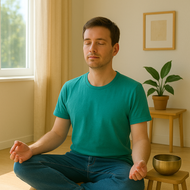A Guide to Meditation Postures and Their Pros and Cons
Posted by Jay Suthers on Oct 30th, 2025
Finding Your Seat: A Guide to Meditation Postures and Their Pros & Cons
Meditation isn’t just about stillness of mind—it’s also about finding a posture that supports your body. Whether you’re sitting, lying down, or even standing, your physical position can shape the quality of your meditation. The right posture helps you stay alert, grounded, and comfortable enough to go inward without distraction.
Let’s explore the most common meditation postures, along with their pros and cons, so you can find the one that best supports your practice.
1. Seated on a Chair
Description: Sit upright in a sturdy chair with feet flat on the floor, spine tall, and hands resting on your thighs or lap.
Pros:
- Accessible for most body types and mobility levels
- Supports the back and legs, reducing strain
- Great for office or travel meditation
Cons:
- Easy to slouch if the chair is too soft
- May reduce the sense of groundedness compared to floor sitting
Best for: Beginners, those with knee or hip issues, or anyone meditating at work
2. Cross-Legged on the Floor (Sukhasana or Easy Pose)
Description: Sit on a cushion or folded blanket with legs crossed, spine upright, and hands resting on knees or in your lap.
Pros:
- Traditional and grounding
- Encourages alertness and stability
- Can be adapted with props for comfort
Cons:
- Can cause discomfort in knees, hips, or ankles over time
- Requires flexibility and core strength for longer sits
Best for: Intermediate practitioners or those seeking a traditional feel
3. Half or Full Lotus (Ardha Padmasana / Padmasana)
Description: One or both feet rest on the opposite thigh, with knees close to the floor and spine erect.
Pros:
- Creates a strong, symmetrical base
- Encourages deep stillness and focus
- Symbolically powerful in many traditions
Cons:
- Can strain knees and hips if not flexible
- Risk of injury if forced or held too long
Best for: Advanced practitioners with open hips and a regular yoga practice
4. Lying Down (Savasana or Corpse Pose)
Description: Lie flat on your back with arms at your sides, palms up, and legs relaxed.
Pros:
- Excellent for body scans, yoga nidra, or deep relaxation
- Reduces physical strain completely
- Ideal for those with chronic pain or fatigue
Cons:
- Easy to fall asleep
- Less alert than seated postures
Best for: Restorative practices, guided meditations, or when the body needs rest
5. Standing Meditation
Description: Stand with feet hip-width apart, knees slightly bent, arms relaxed or in a specific mudra.
Pros:
- Builds strength and stamina
- Enhances energy flow and grounding
- Useful for walking meditation transitions
Cons:
- Can be tiring for long periods
- May be unfamiliar or awkward at first
Best for: Qi Gong, walking meditation prep, or energizing morning practices
6. Walking Meditation
Description: Slow, mindful walking with attention on each step, breath, or sensation.
Pros:
- Integrates mindfulness into movement
- Great for those who struggle with stillness
- Can be done outdoors for added sensory richness
Cons:
- Requires space and focus
- Less introspective than seated meditation
Best for: Active minds, nature lovers, or mid-day resets
Final Thoughts: The Best Posture Is the One That Supports You
There’s no single “correct” meditation posture—only the one that allows you to be present, comfortable, and aware. Your body may need different things on different days. What matters most is that your posture supports your intention: to be still, to listen inward, and to return to yourself.
Try experimenting with different postures and notice how each one affects your breath, focus, and energy. Your body is your meditation cushion—treat it with care.
Shop for Meditation Cushions Here.
I hope this is helpful but please let me know if you have any questions or thoughts.
Sincerely Yours,
Jay
If you have questions or comments regarding this Blog, please feel free to Contact Sage Meditation Customer Service.

